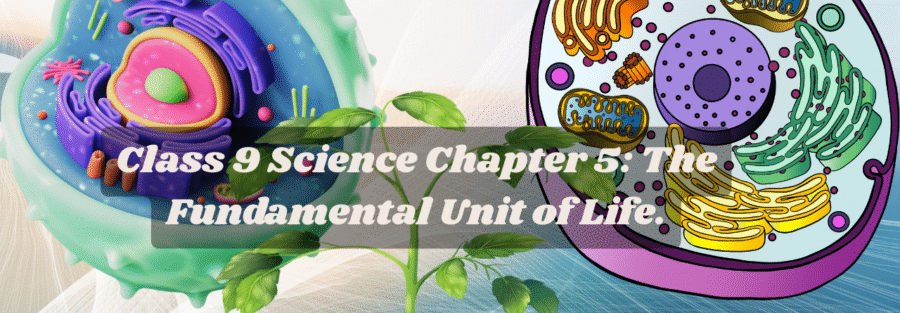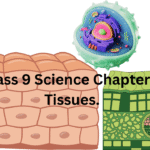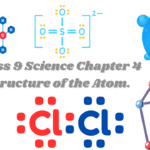Class 9 Science Chapter 5: The Fundamental Unit of Life.
Chapter 5: The Fundamental Unit of Life – Short Notes
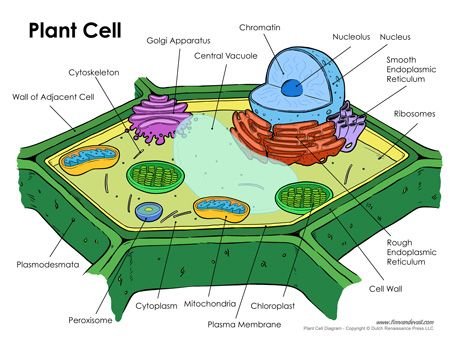
1. Introduction
- The cell is the fundamental structural and functional unit of all living organisms.
- Robert Hooke (1665) discovered cells while observing a thin slice of cork.
- Anton van Leeuwenhoek first observed free-living cells (bacteria, protozoa).
- Cell Theory (proposed by Schleiden and Schwann, later expanded by Virchow):
- All living organisms are composed of one or more cells.
- The cell is the basic unit of structure and function in living organisms.
- All cells arise from pre-existing cells.
2. Structural Organization of a Cell
A cell is composed of three main parts:
- Plasma Membrane (Cell Membrane)
- Nucleus
- Cytoplasm
3. Plasma Membrane (Cell Membrane)
- Structure: A thin, flexible barrier that surrounds the cell. It is selectively permeable.
- Function:
- It separates the contents of the cell from its external environment.
- It regulates the movement of substances in and out of the cell (diffusion, osmosis, active transport).
- Osmosis: The movement of water molecules through a selectively permeable membrane from a region of higher water concentration (dilute solution) to a region of lower water concentration (concentrated solution).
- Hypotonic Solution: Solution outside has higher water concentration (lower solute). Cell gains water by osmosis (swells/lyses).
- Hypertonic Solution: Solution outside has lower water concentration (higher solute). Cell loses water by osmosis (shrinks/plasmolyzes).
- Isotonic Solution: Same water concentration inside and outside the cell. No net movement of water.
4. Cell Wall (Present in Plants, Fungi, Bacteria)
- Structure: A rigid, outer covering made mainly of cellulose. It is fully permeable.
- Function:
- Provides structural strength and shape to the plant cell.
- Prevents the cell from bursting in a hypotonic medium.
5. Nucleus
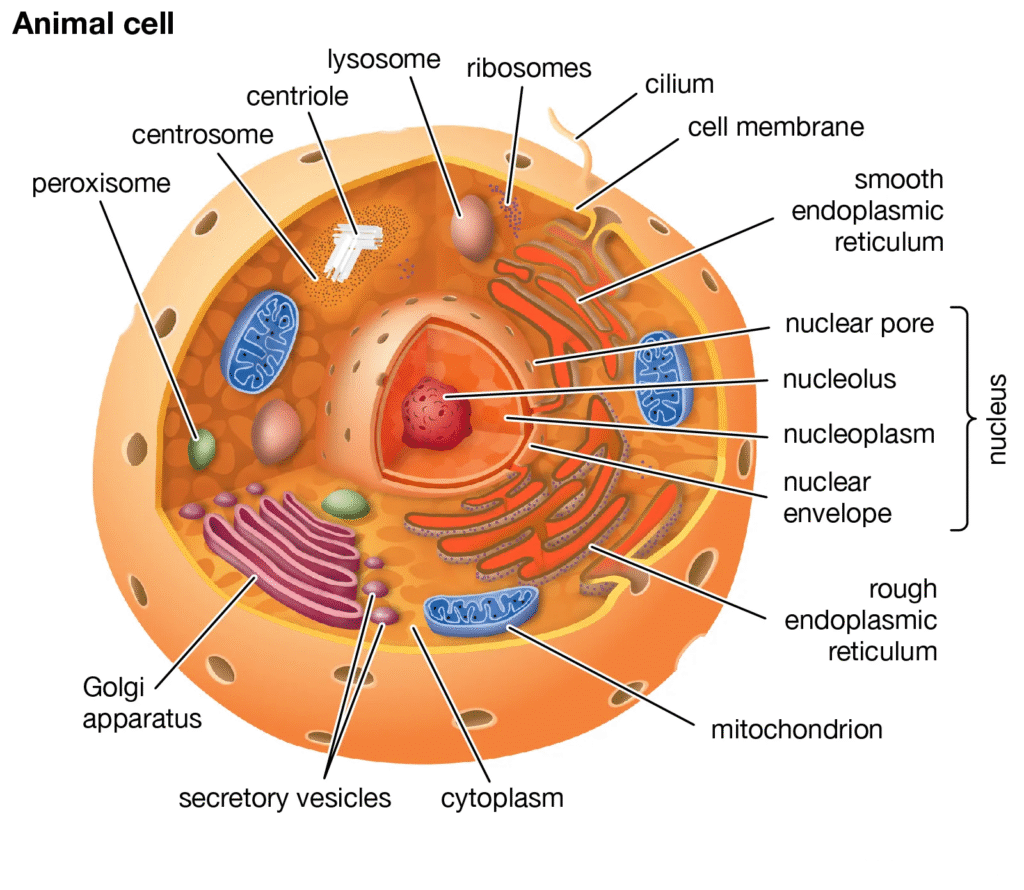
- Structure: Spherical organelle surrounded by a double-layered nuclear membrane with pores. Contains chromatin material (DNA + proteins) which condenses into chromosomes during cell division.
- Function:
- It controls all the activities of the cell (the “control center”).
- It contains hereditary material (DNA) which is responsible for transmitting characters from parents to offspring.
- A nucleus with a distinct membrane is found in eukaryotic cells (plants, animals, fungi, protists). Organisms without a nuclear membrane are prokaryotic (bacteria, blue-green algae).
6. Cytoplasm
- Structure: The jelly-like fluid content between the plasma membrane and the nucleus. It contains various organelles.
- Function: It is the site for many biochemical reactions necessary for life.
7. Cell Organelles
- Endoplasmic Reticulum (ER): A large network of membrane-bound tubes and sheets.
- Rough ER (RER): Has ribosomes attached. Involved in protein synthesis and transport.
- Smooth ER (SER): No ribosomes. Involved in lipid synthesis and detoxification.
- Golgi Apparatus: A stack of membrane-bound vesicles. Its functions include storage, modification, and packaging of products in vesicles for secretion.
- Lysosomes: Membrane-bound sacs filled with digestive enzymes. They digest worn-out organelles, food particles, and engulfed bacteria/viruses. Known as “suicidal bags”.
- Mitochondria: Double-membraned organelles with their own DNA. The site of cellular respiration where energy (ATP) is produced. Known as the “powerhouse of the cell”.
- Plastids (Present only in plant cells):
- Chloroplasts: Contain chlorophyll for photosynthesis.
- Leucoplasts: Store food (starch, oils, proteins).
- Chromoplasts: Contain pigments that give flowers and fruits their colour.
- Vacuoles: Membrane-bound sacs for storage.
- In plant cells: A single, large central vacuole filled with cell sap, which provides turgidity and rigidity.
- In animal cells: Many small vacuoles for storage and excretion.
- Ribosomes: Tiny particles either attached to RER or free in the cytoplasm. They are the sites of protein synthesis.
8. Differences between Plant and Animal Cells
| Feature | Plant Cell | Animal Cell |
|---|---|---|
| Cell Wall | Present | Absent |
| Shape | Usually rectangular (fixed) | Usually round (irregular) |
| Plastids | Present | Absent |
| Vacuole | One large central vacuole | Many small vacuoles |
| Centrioles | Absent | Present |
Important Questions & Answers
Very Short Answer Type Questions (1 Mark)
1. Who discovered the cell?
Ans: Robert Hooke (in 1665).
2. Name the autonomous organelles in the cell.
Ans: Mitochondria and Plastids (they have their own DNA and ribosomes).
3. Where are proteins synthesized inside the cell?
Ans: On ribosomes.
4. What is the function of the Golgi apparatus?
Ans: Storage, modification, and packaging of products in vesicles.
5. What is osmosis?
Ans: The movement of water molecules through a selectively permeable membrane from a region of higher water concentration to a region of lower water concentration.
6. Which cell organelle is called the powerhouse of the cell?
Ans: Mitochondrion.
7. Name the organelle which helps in the formation of lysosome.
Ans: Golgi apparatus.
Short Answer Type Questions (2-3 Marks)
1. State the points of cell theory.
Ans: The cell theory states that:
- All living organisms are composed of one or more cells.
- The cell is the basic unit of structure, function, and organization in all organisms.
- All cells arise from pre-existing, living cells.
2. Why is the plasma membrane called a selectively permeable membrane?
Ans: The plasma membrane allows the movement of only certain substances in and out of the cell while preventing the movement of others. It does not let all substances pass through it freely. Therefore, it is called a selectively permeable membrane.
3. What would happen to a plant cell if it is placed in a hypotonic solution?
Ans: In a hypotonic solution, the external solution has a higher water concentration than the cell. Water will enter the plant cell by osmosis. The cell will swell up and become turgid. The cell wall prevents it from bursting.
4. Draw a well-labelled diagram of a plant cell.
Ans: (In an exam, you would draw this. Ensure to label: Cell Wall, Plasma Membrane, Cytoplasm, Nucleus, Mitochondria, Chloroplast, Vacuole, Golgi apparatus, Endoplasmic Reticulum.)
5. Write the differences between smooth endoplasmic reticulum and rough endoplasmic reticulum.
Ans:
| Smooth Endoplasmic Reticulum (SER) | Rough Endoplasmic Reticulum (RER) |
|---|---|
| Has no ribosomes on its surface. | Has ribosomes attached to its surface. |
| Mainly involved in lipid synthesis. | Mainly involved in protein synthesis. |
| Helps in detoxification in liver cells. | Helps in transporting the synthesized proteins. |
Long Answer Type Questions (5 Marks)
1. a) What are the functions of the following organelles? (i) Lysosomes (ii) Mitochondria
b) Explain the process of osmosis with an example.
Ans:
a)
(i) Lysosomes:
- They contain powerful digestive enzymes.
- They digest foreign materials and pathogens like bacteria and viruses.
- They digest worn-out and damaged cell organelles (autophagy).
- During cellular distress, they may burst and digest their own cell (hence called “suicidal bags”).
(ii) Mitochondria: - They are the sites of cellular respiration.
- They use oxygen and glucose to produce energy in the form of ATP (Adenosine Triphosphate).
- They are known as the “powerhouse of the cell”.
b) Osmosis: It is the movement of water molecules from a region of their higher concentration (dilute solution/ hypotonic) to a region of their lower concentration (concentrated solution/ hypertonic) through a selectively permeable membrane. - Example: When raisins are placed in water (hypotonic solution), water moves into them through osmosis, causing them to swell.
2. a) Draw a neat diagram of an animal cell and label any six parts.
b) List any two features which are present in both plant and animal cells.
Ans:
a) (In an exam, draw a clear diagram of an animal cell and label: Plasma Membrane, Cytoplasm, Nucleus, Mitochondria, Golgi apparatus, Endoplasmic Reticulum, Lysosome, Ribosome, Vacuole.)
b) Two features present in both plant and animal cells are:
- Plasma Membrane: It is the outer boundary in animal cells and lies inside the cell wall in plant cells.
- Nucleus: It is the control center of the cell in both types of cells.
3. a) Differentiate between prokaryotic and eukaryotic cells.
b) Why are lysosomes known as ‘suicidal bags’?
Ans:
a) Differences between Prokaryotic and Eukaryotic Cells:
| Prokaryotic Cell | Eukaryotic Cell |
|---|---|
| Size is generally small (1-10 μm). | Size is generally large (5-100 μm). |
| Nuclear region is not well-defined (nucleoid). | True nucleus with a nuclear membrane. |
| Membrane-bound organelles are absent. | Membrane-bound organelles are present. |
| Example: Bacteria, Blue-green algae. | Example: Plants, Animals, Fungi. |
b) Lysosomes are membrane-bound sacs filled with powerful digestive enzymes. When a cell gets damaged or is old, the lysosome membrane may rupture, allowing the enzymes to be released into the cytoplasm. These enzymes then digest the cell’s own components. Since they are capable of destroying the cell itself, they are called ‘suicidal bags’.
Of course. Here is the study material for Class 9 Science Chapter 5: जीवन की मौलिक इकाई in Hindi, perfect for revision.
अध्याय 5: जीवन की मौलिक इकाई – संक्षिप्त नोट्स
1. परिचय

- कोशिका सभी जीवित जीवों की मौलिक संरचनात्मक और कार्यात्मक इकाई है।
- रॉबर्ट हुक (1665) ने कॉर्क की पतली काट का अवलोकन करते समय कोशिकाओं की खोज की।
- एंटन वॉन ल्यूवेनहॉक ने सबसे पहले स्वतंत्र जीवित कोशिकाओं (जीवाणु, प्रोटोजोआ) का अवलोकन किया।
- कोशिका सिद्धांत (श्लाइडेन और श्वान द्वारा प्रस्तावित, बाद में विर्चो द्वारा विस्तारित):
- सभी जीवित जीव एक या अधिक कोशिकाओं से बने होते हैं।
- कोशिका जीवित जीवों में संरचना और कार्य की मूल इकाई है।
- सभी कोशिकाएं पहले से मौजूद कोशिकाओं से उत्पन्न होती हैं।
2. कोशिका की संरचनात्मक संगठन
एक कोशिका तीन मुख्य भागों से बनी होती है:
- प्लाज्मा झिल्ली (कोशिका झिल्ली)
- केंद्रक
- कोशिका द्रव्य
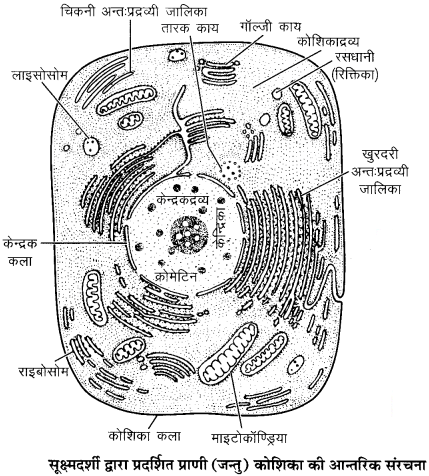
3. प्लाज्मा झिल्ली (कोशिका झिल्ली)
- संरचना: एक पतली, लचीली झिल्ली जो कोशिका को घेरे रहती है। यह वरणात्मक पारगम्य होती है।
- कार्य:
- यह कोशिका की सामग्री को उसके बाहरी वातावरण से अलग करती है।
- यह कोशिका के अंदर और बाहर पदार्थों के आवागमन को नियंत्रित करती है (प्रसार, परासरण, सक्रिय परिवहन)।
- परासरण: जल के अणुओं का वरणात्मक पारगम्य झिल्ली के माध्यम से उच्च जल सांद्रता (तनु विलयन) के क्षेत्र से निम्न जल सांद्रता (गाढ़ा विलयन) के क्षेत्र की ओर गमन।
- अल्पपरासरी विलयन: बाहर का विलयन जिसमें जल की सांद्रता अधिक (विलेय कम) होती है। कोशिका परासरण द्वारा जल ग्रहण करती है (फूल जाती है/फट सकती है)।
- अतिपरासरी विलयन: बाहर का विलयन जिसमें जल की सांद्रता कम (विलेय अधिक) होती है। कोशिका परासरण द्वारा जल खो देती है (सिकुड़ जाती है/जीवद्रव्य कुंचन)।
- समपरासरी विलयन: कोशिका के अंदर और बाहर जल सांद्रता समान होती है। जल का कोई शुद्ध आवागमन नहीं होता।
4. कोशिका भित्ति (पादप, कवक, जीवाणु में उपस्थित)
- संरचना: मुख्यतः सेल्यूलोज से बनी एक कठोर, बाहरी परत। यह पूर्णतः पारगम्य होती है।
- कार्य:
- पादप कोशिका को संरचनात्मक शक्ति और आकार प्रदान करती है।
- अल्पपरासरी माध्यम में कोशिका को फटने से रोकती है।
5. केंद्रक
- संरचना: एक गोलाकार अंगक जो दोहरी परत वाली केंद्रक झिल्ली से घिरा होता है, जिसमें छिद्र होते हैं। इसमें क्रोमैटिन पदार्थ (DNA + प्रोटीन) होता है जो कोशिका विभाजन के दौरान गुणसूत्रों में संघनित हो जाता है।
- कार्य:
- यह कोशिका की सभी क्रियाओं को नियंत्रित करता है (“नियंत्रण केंद्र”)।
- इसमें वंशानुगत पदार्थ (DNA) होता है जो माता-पिता से संतानों में लक्षणों के हस्तांतरण के लिए जिम्मेदार है।
- एक विशिष्ट झिल्ली वाला केंद्रक यूकैरियोटिक कोशिकाओं (पादप, जंतु, कवक, प्रोटिस्ट) में पाया जाता है। जिन जीवों में केंद्रक झिल्ली नहीं होती, वे प्रोकैरियोटिक (जीवाणु, नील-हरित शैवाल) होते हैं।
6. कोशिका द्रव्य
- संरचना: प्लाज्मा झिल्ली और केंद्रक के बीच का जेली जैसा द्रव पदार्थ। इसमें विभिन्न अंगक होते हैं।
- कार्य: यह जीवन के लिए आवश्यक कई जैव रासायनिक अभिक्रियाओं का स्थल है।
7. कोशिकांग (Cell Organelles)
- अंतर्द्रव्यी जालिका (ER): झिल्ली-बद्ध नलिकाओं और चादरों का एक बड़ा नेटवर्क।
- खुरदरी अंतर्द्रव्यी जालिका (RER): इसकी सतह पर राइबोसोम जुड़े होते हैं। प्रोटीन संश्लेषण और परिवहन में involved।
- चिकनी अंतर्द्रव्यी जालिका (SER): कोई राइबोसोम नहीं। लिपिड संश्लेषण और विष-निराकरण में involved।
- गॉल्जी उपकरण: झिल्ली-बद्ध थैलियों का ढेर। इसके कार्यों में उत्पादों का भंडारण, संशोधन और पैकेजिंग करना शामिल है, ताकि उन्हें स्राव के लिए पुटिकाओं में भेजा जा सके।
- लाइसोसोम: शक्तिशाली पाचक एंजाइमों से भरी झिल्ली-बद्ध थैलियाँ। ये खराब हो चुके अंगकों, खाद्य कणों और निगले गए जीवाणुओं/वायरस को पचाती हैं। “आत्मघाती थैली” के नाम से जानी जाती हैं।
- सूत्रकणिका (माइटोकॉन्ड्रिया): दोहरी झिल्ली वाले अंगक जिनका अपना DNA होता है। कोशिकीय श्वसन का स्थल, जहाँ ऊर्जा (ATP) उत्पन्न होती है। “कोशिका का शक्ति केंद्र” कहलाता है।
- प्लैस्टिड (केवल पादप कोशिकाओं में उपस्थित):
- हरितलवक (क्लोरोप्लास्ट): इनमें प्रकाश संश्लेषण के लिए क्लोरोफिल होता है।
- श्वेतलवक (ल्यूकोप्लास्ट): भोजन (स्टार्च, तेल, प्रोटीन) का भंडारण करते हैं।
- वर्णलवक (क्रोमोप्लास्ट): इनमें वर्णक होते हैं जो फूलों और फलों को उनका रंग देते हैं।
- रिक्तिकाएँ (Vacuoles): भंडारण के लिए झिल्ली-बद्ध थैलियाँ।
- पादप कोशिकाओं में: एक बड़ी, केंद्रीय रिक्तिका होती है जो कोशिका रस से भरी होती है, जो स्फीति और दृढ़ता प्रदान करती है।
- जंतु कोशिकाओं में: भंडारण और उत्सर्जन के लिए कई छोटी रिक्तिकाएँ होती हैं।
- राइबोसोम: छोटे कण जो RER से जुड़े होते हैं या कोशिका द्रव्य में स्वतंत्र रूप से तैरते हैं। ये प्रोटीन संश्लेषण के स्थल हैं।
8. पादप और जंतु कोशिका में अंतर
| लक्षण | पादप कोशिका | जंतु कोशिका |
|---|---|---|
| कोशिका भित्ति | उपस्थित | अनुपस्थित |
| आकार | आयताकार (निश्चित) | गोल (अनियमित) |
| प्लैस्टिड | उपस्थित | अनुपस्थित |
| रिक्तिका | एक बड़ी केंद्रीय रिक्तिका | कई छोटी रिक्तिकाएँ |
| तारककेंद्र (सेंट्रिओल) | अनुपस्थित | उपस्थित |
महत्वपूर्ण प्रश्न एवं उत्तर
अति लघु उत्तरीय प्रश्न (1 अंक)
1. कोशिका की खोज किसने की?
उत्तर: रॉबर्ट हुक (1665 में)।
2. कोशिका में स्वायत्त अंगकों के नाम बताइए।
उत्तर: सूत्रकणिका (माइटोकॉन्ड्रिया) और प्लैस्टिड (इनमें अपना DNA और राइबोसोम होता है)।
3. कोशिका के अंदर प्रोटीन का संश्लेषण कहाँ होता है?
उत्तर: राइबोसोम पर।
4. गॉल्जी उपकरण का कार्य क्या है?
उत्तर: उत्पादों का भंडारण, संशोधन और पुटिकाओं में पैकेजिंग करना।
5. परासरण क्या है?
उत्तर: जल के अणुओं का वरणात्मक पारगम्य झिल्ली के माध्यम से उच्च जल सांद्रता वाले क्षेत्र से निम्न जल सांद्रता वाले क्षेत्र की ओर गमन।
6. कोशिका के किस अंगक को कोशिका का शक्ति केंद्र कहा जाता है?
उत्तर: सूत्रकणिका (माइटोकॉन्ड्रिया)।
7. उस अंगक का नाम बताइए जो लाइसोसोम के निर्माण में helps करता है।
उत्तर: गॉल्जी उपकरण।
लघु उत्तरीय प्रश्न (2-3 अंक)
1. कोशिका सिद्धांत के बिंदु लिखिए।
उत्तर: कोशिका सिद्धांत के अनुसार:
- सभी जीवित जीव एक या अधिक कोशिकाओं से बने होते हैं।
- कोशिका सभी जीवों में संरचना, कार्य और संगठन की मूल इकाई है।
- सभी कोशिकाएं पहले से मौजूद, जीवित कोशिकाओं से उत्पन्न होती हैं।
2. प्लाज्मा झिल्ली को वरणात्मक पारगम्य झिल्ली क्यों कहा जाता है?
उत्तर: प्लाज्मा झिल्ली केवल कुछ विशिष्ट पदार्थों को कोशिका के अंदर और बाहर आने-जाने देती है जबकि अन्य पदार्थों के आवागमन को रोकती है। यह सभी पदार्थों को स्वतंत्र रूप से से नहीं गुजरने देती। इसलिए, इसे वरणात्मक पारगम्य झिल्ली कहा जाता है।
3. यदि किसी पादप कोशिका को अल्पपरासरी विलयन में रखा जाए तो क्या होगा?
उत्तर: अल्पपरासरी विलयन में, बाहरी विलयन में कोशिका की तुलना में जल की सांद्रता अधिक होती है। परासरण द्वारा जल पादप कोशिका के अंदर प्रवेश करेगा। कोशिका फूल जाएगी और स्फीत (टर्जिड) हो जाएगी। कोशिका भित्ति इसे फटने से रोकती है।
4. एक पादप कोशिका का सुस्पष्ट नामांकित चित्र बनाइए।
उत्तर: (परीक्षा में इसे बनाना होगा। इन्हें अवश्य लेबल करें: कोशिका भित्ति, प्लाज्मा झिल्ली, कोशिका द्रव्य, केंद्रक, सूत्रकणिका, हरितलवक, रिक्तिका, गॉल्जी उपकरण, अंतर्द्रव्यी जालिका।)
5. चिकनी अंतर्द्रव्यी जालिका और खुरदरी अंतर्द्रव्यी जालिका के बीच अंतर लिखिए।
उत्तर:
| चिकनी अंतर्द्रव्यी जालिका (SER) | खुरदरी अंतर्द्रव्यी जालिका (RER) |
|---|---|
| इसकी सतह पर राइबोसोम नहीं होते। | इसकी सतह पर राइबोसोम जुड़े होते हैं। |
| मुख्यतः लिपिड संश्लेषण में involved। | मुख्यतः प्रोटीन संश्लेषण में involved। |
| यकृत कोशिकाओं में विष-निराकरण में helps करती है। | संश्लेषित प्रोटीन के परिवहन में helps करती है। |
दीर्घ उत्तरीय प्रश्न (5 अंक)
1. a) निम्नलिखित अंगकों के कार्य लिखिए: (i) लाइसोसोम (ii) सूत्रकणिका
b) एक उदाहरण देकर परासरण की प्रक्रिया की व्याख्या कीजिए।
उत्तर:
a)
(i) लाइसोसोम:
- इनमें शक्तिशाली पाचक एंजाइम होते हैं।
- ये बाहरी सामग्री और रोगाणुओं (जीवाणु, विषाणु) को पचाते हैं।
- ये खराब और क्षतिग्रस्त कोशिकांगों को पचाते हैं (ऑटोफेजी)।
- कोशिकीय संकट के दौरान, ये फट सकते हैं और अपनी ही कोशिका को पचा सकते हैं (इसलिए “आत्मघाती थैली” कहलाते हैं)।
(ii) सूत्रकणिका: - ये कोशिकीय श्वसन के स्थल हैं।
- ये ऑक्सीजन और ग्लूकोज का उपयोग करके ATP (एडेनोसिन ट्राइफॉस्फेट) के रूप में ऊर्जा उत्पन्न करते हैं।
- इन्हें “कोशिका का शक्ति केंद्र” कहा जाता है।
b) परासरण: यह जल अणुओं का एक वरणात्मक पारगम्य झिल्ली के माध्यम से उनके उच्च सांद्रता वाले क्षेत्र (तनु विलयन/ अल्पपरासरी) से निम्न सांद्रता वाले क्षेत्र (गाढ़ा विलयन/ अतिपरासरी) की ओर गमन है। - उदाहरण: जब किशमिश को पानी (अल्पपरासरी विलयन) में रखा जाता है, तो परासरण द्वारा उनमें पानी प्रवेश करता है, जिससे वे फूल जाते हैं।
2. a) एक जंतु कोशिका का स्वच्छ नामांकित चित्र बनाइए और उसके कोई छ: भागों के नाम लिखिए।
b) कोई दो ऐसी विशेषताएँ लिखिए जो पादप और जंतु दोनों कोशिकाओं में उपस्थित होती हैं।
उत्तर:
a) (परीक्षा में एक स्पष्ट जंतु कोशिका का चित्र बनाएं और लेबल करें: प्लाज्मा झिल्ली, कोशिका द्रव्य, केंद्रक, सूत्रकणिका, गॉल्जी उपकरण, अंतर्द्रव्यी जालिका, लाइसोसोम, राइबोसोम, रिक्तिका।)
b) पादप और जंतु दोनों कोशिकाओं में उपस्थित दो विशेषताएँ हैं:
- प्लाज्मा झिल्ली: यह जंतु कोशिकाओं में बाहरी सीमा है और पादप कोशिकाओं में कोशिका भित्ति के अंदर स्थित होती है।
- केंद्रक: यह दोनों प्रकार की कोशिकाओं का नियंत्रण केंद्र है।
3. a) प्रोकैरियोटिक और यूकैरियोटिक कोशिकाओं में अंतर स्पष्ट कीजिए।
b) लाइसोसोम को ‘आत्मघाती थैली’ क्यों कहा जाता है?
उत्तर:
a) प्रोकैरियोटिक और यूकैरियोटिक कोशिकाओं में अंतर:
| प्रोकैरियोटिक कोशिका | यूकैरियोटिक कोशिका |
|---|---|
| आकार आम तौर पर छोटा (1-10 μm) होता है। | आकार आम तौर पर बड़ा (5-100 μm) होता है। |
| केंद्रकीय क्षेत्र सुपरिभाषित नहीं होता (केन्द्रकाभ)। | केंद्रक झिल्ली के साथ वास्तविक केंद्रक होता है। |
| झिल्ली-बद्ध अंगक अनुपस्थित होते हैं। | झिल्ली-बद्ध अंगक उपस्थित होते हैं। |
| उदाहरण: जीवाणु, नील-हरित शैवाल। | उदाहरण: पादप, जंतु, कवक। |
b) लाइसोसोम झिल्ली-बद्ध थैलियाँ हैं जो शक्तिशाली पाचक एंजाइमों से भरी होती हैं। जब कोई कोशिका क्षतिग्रस्त हो जाती है या पुरानी हो जाती है, तो लाइसोसोम की झिल्ली फट सकती है, जिससे एंजाइम कोशिका द्रव्य में निकल जाते हैं। ये एंजाइम तब कोशिका के अपने ही घटकों को पचाने लगते हैं। चूंकि ये कोशिका को स्वयं नष्ट करने में सक्षम हैं, इसलिए इन्हें ‘आत्मघाती थैली’ कहा जाता है।
